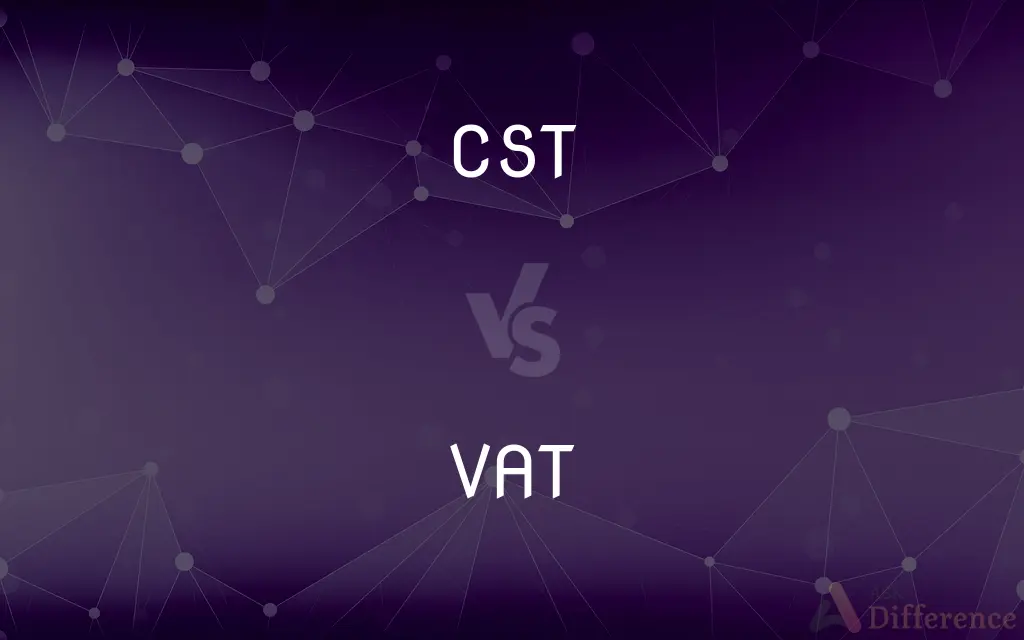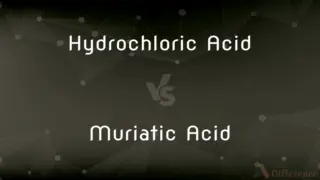CST vs. VAT — What's the Difference?
By Tayyaba Rehman — Published on December 7, 2023
CST (Central Sales Tax) is a tax on inter-state sales in India, while VAT (Value Added Tax) is a consumption tax levied on value added at each production or distribution stage.

Difference Between CST and VAT
Table of Contents
ADVERTISEMENT
Key Differences
CST and VAT are both indirect taxation methods implemented in India, but they are applied under different scenarios and for different purposes.
CST, standing for Central Sales Tax, is specifically applied to sales that occur between two different states within India. On the contrary, VAT, or Value Added Tax, is imposed on goods and services, focusing on the value added at each stage of production or distribution.
While CST is levied by the central government, VAT is implemented by state governments. This means that CST remains uniform across states, but VAT rates may differ from one state to another.
A crucial distinction between CST and VAT lies in their application; while CST is singular in its imposition on inter-state sales, VAT gets charged multiple times as goods/services pass through various production or distribution stages.
To sum up, while CST ensures taxation on goods sold between states, VAT ensures that the end consumer bears the tax burden by taxing the value added throughout the product's lifecycle.
ADVERTISEMENT
Comparison Chart
Full Form
Central Sales Tax
Value Added Tax
Applicability
Inter-state sales within India
On goods and services at each production or distribution stage
Levied By
Central Government
State Governments
Nature
Uniform across states
Can vary from state to state
Point of Imposition
Singular, on inter-state sales
Multiple times, at each value-added stage
Compare with Definitions
CST
Uniform tax across all Indian states.
CST remains consistent regardless of the states involved in the transaction.
VAT
A tax on value addition in the product lifecycle.
The price of the product includes the VAT charged at each production stage.
CST
Imposed on goods moving between states.
When transporting goods from Uttar Pradesh to Kerala, CST applies.
VAT
A consumption tax borne by the end consumer.
As consumers, we pay VAT on most of our purchases.
CST
A tax on sales between Indian states.
The company had to pay CST for selling goods to a neighboring state.
VAT
Applied at various production or distribution points.
VAT is imposed at every stage where value is added to the product.
CST
An indirect tax levied by the central government.
The central government oversees the collection of CST on inter-state transactions.
VAT
Levied by state governments in India.
Different states in India might have varying VAT rates on similar products.
CST
Ensures taxation of inter-state commerce.
For businesses engaged in inter-state trade, understanding CST is crucial.
VAT
Aims to distribute the tax burden across the supply chain.
Manufacturers, wholesalers, and retailers all contribute to VAT before the product reaches the consumer.
CST
Standard time in the 6th time zone west of Greenwich, reckoned at the 90th meridian; used in the central United States
VAT
A large vessel, such as a tub, cistern, or barrel, used to hold or store liquids.
VAT
To put into or treat in a vat.
VAT
A large tub, such as is used for making wine or for tanning.
A vat of liquid
A vat of acid
A vat of wine
A vat of olives
A vat of fat
A vat of glue
VAT
A square, hollow place on the back of a calcining furnace, where tin ore is laid to dry.
VAT
(Roman Catholic) A vessel for holding holy water.
VAT
(dated) A liquid measure and dry measure; especially, a liquid measure in Belgium and Holland, corresponding to the hectolitre of the metric system, which contains 22.01 imperial gallons, or 26.4 standard gallons in the United States.
VAT
(transitive) To put into a vat.
VAT
(transitive) To blend (wines or spirits) in a vat; figuratively, to mix or blend elements as if with wines or spirits.
VAT
A large vessel, cistern, or tub, especially one used for holding liquors in an immature state, chemical preparations for dyeing, or for tanning, or for tanning leather, or the like.
Let him produce his vats and tubs, in opposition to heaps of arms and standards.
VAT
A measure for liquids, and also a dry measure; especially, a liquid measure in Belgium and Holland, corresponding to the hectoliter of the metric system, which contains 22.01 imperial gallons, or 26.4 standard gallons in the United States.
VAT
A wooden tub for washing ores and mineral substances in.
VAT
A vessel for holding holy water.
VAT
To put or transfer into a vat.
VAT
A tax levied on the difference between a commodity's price before taxes and its cost of production
VAT
A large open vessel for holding or storing liquids
Common Curiosities
How is VAT different from a sales tax?
VAT is levied on the value added at each production or distribution stage, while sales tax is on the final sale to the consumer.
Where is CST applicable?
CST is applicable to inter-state sales within India.
Who levies the CST?
The CST is levied by the central government of India.
Can VAT rates differ within a country?
Yes, in countries like India, VAT rates can differ from one state to another.
How often is VAT imposed on a product?
VAT is imposed multiple times, at each stage where value is added to the product.
Which tax ensures the end consumer bears the tax burden?
VAT ensures that the end consumer ultimately bears the tax burden.
Is CST applicable to services?
No, CST is primarily for inter-state sales of goods.
How does VAT impact product pricing?
VAT is usually included in the product's price, making products more expensive for the end consumer.
What do CST and VAT stand for?
CST stands for Central Sales Tax, and VAT stands for Value Added Tax.
Why is CST uniform across states?
CST is uniform because it's governed by the central government, ensuring consistency across states.
Is VAT applicable only in India?
No, VAT is a global concept and is used in many countries with different names and structures.
Does every country have both CST and VAT systems?
No, the CST system is specific to India, while VAT or similar systems exist in many countries.
Why is VAT considered a more transparent taxation method?
Because VAT is levied at each value-added stage, it's considered transparent and distributes the tax burden.
Can a product be subjected to both CST and VAT?
In some scenarios, a product can attract both CST and VAT, but typically they are mutually exclusive.
If I buy a product in one state and sell it in another, do I pay CST or VAT?
If you're involved in inter-state trade, you would typically pay CST.
Share Your Discovery

Previous Comparison
Hydrochloric Acid vs. Muriatic Acid
Next Comparison
Samsung Dishwasher vs. Bosch DishwasherAuthor Spotlight
Written by
Tayyaba RehmanTayyaba Rehman is a distinguished writer, currently serving as a primary contributor to askdifference.com. As a researcher in semantics and etymology, Tayyaba's passion for the complexity of languages and their distinctions has found a perfect home on the platform. Tayyaba delves into the intricacies of language, distinguishing between commonly confused words and phrases, thereby providing clarity for readers worldwide.












































